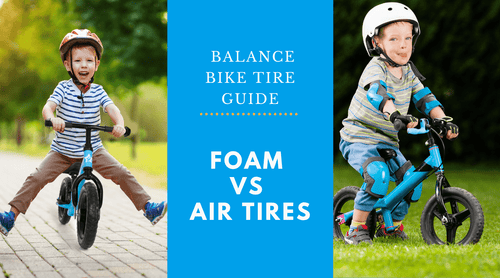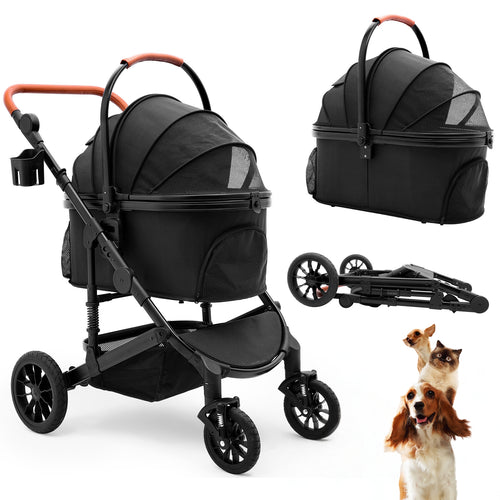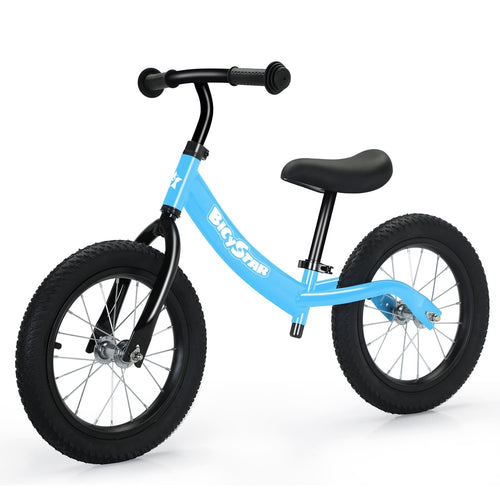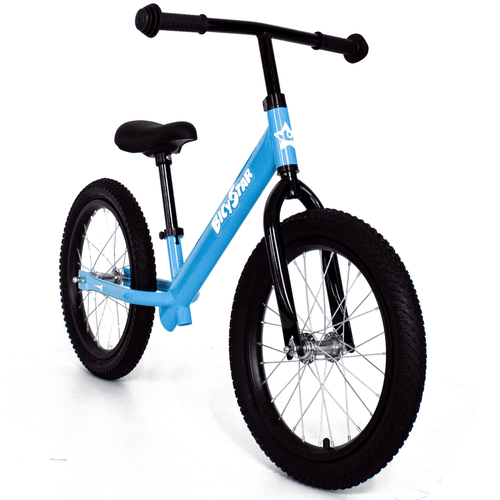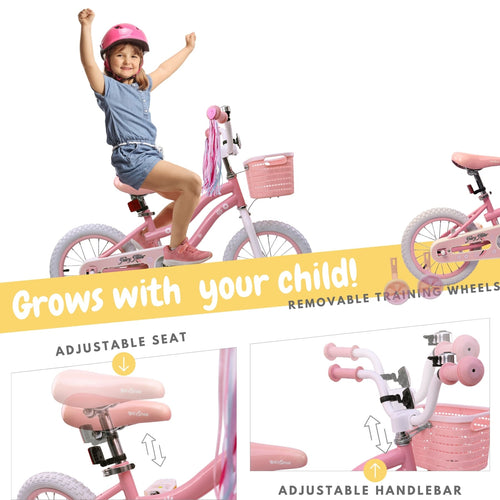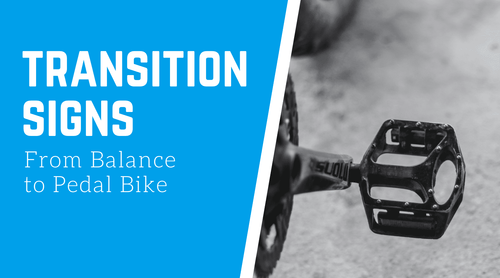Introduction
The journey into the world of cycling begins with those first few confident strides on a balance bike before moving to a pedal bike. As a parent or guardian, selecting the right type of tire for your child's balance bike is pivotal in setting the foundation for a secure and enjoyable riding experience. Today, I'm going to take you through a detailed exploration of the two prevalently debated tire options for balance bikes: air tires and foam tires. Each holds its unique set of advantages and potential drawbacks, and understanding these can be the key to unlocking hours of fun and developmental growth for your little rider.
When we talk about the best balance bike for your toddler, we're really talking about customizing a riding experience that suits their developmental stage, environment, and your family's lifestyle needs. Whether you're traversing the rugged paths of outdoor trails or cruising the flat pavements of an urban setting, the tires you choose can drastically alter the bike's performance. Will the robust features of a bike with air tires cater to your adventurous tot? Or will the practical and maintenance-free nature of foam tires be the more appealing route?

Delving into the realm of balance bikes isn't just about a playful pastime; it's about equipping your toddler with the skills necessary for the eventual transition to a pedal bike. The balance, coordination, and confidence fostered by these early rides are invaluable. So let's begin this journey by evaluating the foundations—quite literally—of what makes these bikes roll: their tires. Sit tight, because by the end of this post, you'll be well-equipped to select a tire type that won't just fit the bike but will fit your child's blossoming life on two wheels. And remember, if you find this guide insightful, don't hesitate to subscribe to our newsletter for more handy tips and in-depth guidance on your child's biking adventure.
What Makes a Balance Bike the Best Choice for Your Toddler?
Balance bikes are more than just a trendy toy; they're an educational tool that can significantly benefit your toddler's development. Unlike traditional bicycles, balance bikes do away with pedals, allowing your toddler to focus solely on one skill at a time—balancing. This simplicity is the key to why they're often hailed as the best balance bike option for young children.
Let's get into why a push bike could be a game-changer for your toddler. Firstly, it encourages kids to use their legs for movement, which strengthens their muscles and improves coordination. With their feet readily available to steady themselves, toddlers feel more secure, boosting their confidence to experiment with movement. This direct contact with the ground also provides an immediate sense of control that can be less intimidating than pedal bikes, making balance bikes particularly suitable for cautious children or those with a cautious temperament.
In addition, balance bikes make the transition to a pedal bike smoother. When the time comes for your toddler to graduate from balance bike to a pedal bike, they are often able to skip the bike with training wheels stage altogether. By then, they've already mastered the hardest part of cycling—balancing. With balance under their little belts, they just need to learn the motion of pedaling, which is often picked up rapidly thanks to the muscle memory and coordination developed on their balance bike.
Now, you might be thinking: to deliver all these benefits, surely the balance bike itself needs to be top-notch? Absolutely, and a big part of that comes down to the tires. The right choice in tires for a push bike can offer the correct resistance, grip, and comfort for your toddler, paving the way for endless joyous hours of learning and exploration.
Air Tires or Foam Tires: Understanding the Differences
When it comes to the tires of the best balance bikes for preschoolers, the debate typically centers around one question: air tires or foam tires? The choice may appear trivial at first, but delve a little deeper, and you realize that tires are the critical point of contact between your child and the ground they’re learning to navigate.

Air Tires: Cushioning and Performance
Air tires, similar to those on a standard pedal bicycle, are inflatable and offer that much-desired cushioning effect which is particularly advantageous over uneven surfaces. The versatility of a kids bike with air tires shines when taken on various terrains, providing a smooth ride over bumps and dips — a feature that tends to absorb shock better than foam tires. This air cushioning can be crucial in preventing jarring impacts that could unsettle your toddler's ride and confidence.
Another considerable advantage of air tires on a push bike is their grip. Rubber air tires naturally have a more substantial grip on surfaces ranging from wet pavement to loose gravel, making them safer in terms of traction. This can be especially important for adventurous little riders who are likely to test the limits of their bikes in different settings. But this enhanced performance comes with the responsibility of maintenance. Regular pressure checks and puncture repairs are part and parcel of owning a balance bike with air filled tires.
Foam Tires: Ease and Safety
On the flip side, foam tires offer a unique set of benefits primarily centered around convenience. Being puncture-proof, they eliminate the concern of running into trouble during a jaunt around the park or neighborhood — peace of mind that many parents can certainly appreciate. Moreover, they are significantly lighter than air tires, which can make a balance bike easier to handle for a young rider. This can aid in the maneuverability of the bike, an important aspect when your child is learning to steer and control their bike confidently.
Additionally, foam tires tend to be more durable in the traditional sense; there's no risk of a deflated ride due to overuse or sharp objects. This feature makes them attractive for parents looking for a low-maintenance option. However, it's important to weigh convenience with performance. Foam tires typically don't offer the same shock absorption and traction as air tires. Consequently, the balance bike may perform with a bit more jolt on uneven terrain, and the level of grip may not be as secure in certain outdoor environments.
In essence, the choice between air and foam tires on a balance bike boils down to your toddler's needs, where they will primarily ride, and the effort you're willing to put into bike maintenance. It's a balance of performance versus convenience, cushioning versus durability. Making the right tire selection will empower your child's riding experience and support their journey from a balance bike apprentice to a pedaling pro on a pedal bike.
How to Choose the Perfect Balance Bike with Air Tires for Outdoor Adventures
When the call of the outdoors beckons, a balance bike with air tires might just be what your young explorer needs. Air tires are significantly better at handling the unpredictable nature of outdoor terrain, from park paths to nature trails. But how do you choose the perfect balance bike for your toddler that can handle such adventures?

Firstly, consider the type of outdoor environments your child will be riding in. If your family enjoys off-road excursions or you live in an area with lots of green spaces, the superior traction and shock absorption of air tires will offer a safer and more comfortable ride for your little rider. Look for tires with deep treads, which provide better grip on loose surfaces like dirt, gravel, or wet grass, ensuring that your toddler can focus on balancing and steering without the bike slipping out from under them.
In addition, pay attention to tire size. Larger tires roll over obstacles more easily than smaller ones, which is a significant advantage when riding outdoors. A balance bike equipped with larger air tires can manage bumps and dips better, granting a smoother ride that's less likely to be interrupted by small rocks or tree roots. This size factor also contributes to speed stability; a bike with larger tires tends to move faster but is also more stable at speed—a plus for adventurous toddlers eager to zoom along.
However, it's also necessary to talk about maintenance when it comes to air tires. Yes, the upkeep can be somewhat more demanding—air tires will need regular pressure checks to ensure they're inflated correctly for optimal performance and safety. A well-inflated tire reduces the rolling resistance, making the bike easier to control, especially at higher speeds often encountered outdoors. Moreover, staying vigilant about tire pressure can prevent premature wear and tear, preserving the life of the tires.
So, when selecting a balance bike with air tires, it's not just about the adventures they can withstand, but also about considering the responsibility they come with. As a plus, by involving your toddler in the maintenance process, you can cultivate a sense of responsibility and introduce them to the basics of bike care—an invaluable lesson for any budding cyclist.
The Role of Foam Tires in Your Toddler’s Learning Curve
Selecting the right balance bike for your toddler is a fundamental step in fostering their growth and independence. Foam tires play a distinctive role in this early stage by providing a maintenance-free option that enables young riders to focus solely on the joy of learning to ride.
Foam tires are the epitome of convenience and safety for early riders. Their lightweight construction can be a significant advantage for toddlers who are just beginning to develop their physical coordination and strength. A balance bike outfitted with foam tires is easier to propel, maneuver, and correct, allowing the rider to handle the bike with greater ease and less fatigue. This aspect is crucial for keeping toddlers engaged and eager to ride without becoming overwhelmed by a bike that is cumbersome to control.

Beyond ease of handling, safety is paramount when it comes to teaching your child to ride, and foam tires often provide a more stable platform. This stability stems from the rigid nature of foam, which offers a consistent ride without the risks of deflation mid-adventure. For parents, the relief of not having to worry about flat tires means less downtime and more continual riding enjoyment for their toddler. Furthermore, the solid construction of foam tires might mean less speed and less bounce, which can act as a natural speed limiter for the bike—something that novice riders and protective parents may find highly beneficial.
Yet, one must consider the trade-offs. Foam tires are not without their limitations, particularly concerning the lack of shock absorption compared to their air-filled counterparts. While they can handle urban sidewalks and smooth paths adeptly, they may not provide the same level of comfort on rougher ground. Consequently, if you live in an area with varied terrain or your toddler likes to dabble in different environments, it's essential to weigh the potential impact this could have on their comfort and riding experience.
To sum up, foam tires may not be the universal choice for every scenario, but they hold a reputable place as a practical option for introducing toddlers to balance biking. They limit maintenance, offer a stable starting point, and encourage continuous riding — all key components in the tapestry of a successful, early cycling experience. As a result, these tires might just be the perfect fit for a young rider's initial ventures, leaving the transition to air tires as their skills and confidence expand.
Selecting the Best Balance Bikes for Preschoolers: Features to Look For
As a parent striving to provide your preschooler with the perfect balance bike, you might wonder what features are non-negotiable to ensure a safe, fun, and developmental riding experience. When immersed in the world of the best balance bikes for preschoolers, several attributes should guide your selection process.

First and foremost, seat height is critical. The best balance bike for any kids of all ages is one that fits them right now, not one they will grow into. Preschoolers should be able to sit on the bike with their feet flat on the ground, allowing for proper leg extension as they push off. This means looking for a bike with an adjustable seat is essential. It not only provides a custom fit as your preschooler grows but also ensures proper posture and riding mechanics from day one.
Next on the list is the bike’s weight. A general rule of thumb is that the bike should not weigh more than 30% of the child's weight. A heavier bike can prove challenging for a little rider to maneuver and control, possibly discouraging them from biking altogether. Weight impacts everything—from the ease of taking those first strides to the ability to steer correctly and even pick up the bike after a fall.
Handlebar grips are another critical feature often overlooked. They should be sized correctly for small hands and provide a secure grip, especially on balance bikes for toddlers. Look for grips that come with bumpers or safety ends, as they provide additional protection should your child tumble or brush against walls or other objects.
Finally, tires - as we've discussed at length - remain a paramount feature. Whether you choose a balance bike with air tires or foam tires, they should be durable, appropriate for the riding surfaces your child will encounter most often, and align with your readiness to maintain them.
In searching for the perfect balance bike, consider these key characteristics carefully. A well-fitted, appropriately sized, and safely constructed balance bike will not only be more enjoyable but will also significantly enhance your child's riding proficiency and love for cycling. These features work in conjunction to support your child's developing balance and provide joyful learning experiences as they prepare to transition to a pedal bike.
Conclusion
Choosing the right balance bike tires is a journey through a landscape of comfort, safety, and practicality. Whether you choose the cushioned adaptability of air tires or the puncture-proof ease of foam, both feature in the storybook of your toddler’s early riding experiences. Air tires offer a luxurious glide over rugged terrains, making outdoor explorations a delightful adventure, while foam tires infuse a confidence-building steadiness ideal for a beginner's first whirls and twirls.

Understanding the role of each type of tire in your toddler's learning curve on a pedal-less push bike allows you to personalize the cycling experience to their distinct growth path. For the family that foresees frequent outdoor escapades involving varied terrains, investing in a balance bike with robust air tires may prove wise. Yet, for many, the unrivaled convenience and reliability of foam tires may align more seamlessly with the relaxed, everyday strolls through the neighborhood.
As we nudge our toddlers along, from those shaky first mounts to the confident, pedal-powered zooms, let's recall how crucial our choices are in shaping their riding experiences. The correct tire selection lays down the tracks for a multitude of tomorrow’s rides.
Bullet Point Summary:
- Balance bikes are instrumental in developing your child's coordination and confidence, setting the stage for a smooth transition to pedal bikes.
- Air tires offer better shock absorption and traction for varied outdoor surfaces but require regular maintenance.
- Foam tires provide convenience and stability, perfect for beginners and casual rides on smoother terrains.
- Key features to consider in a balance bike for preschoolers include adjustable seat height, lightweight frame, safe grip handles, and tire type.
And as you pedal forward in your decision-making process, remember, the best choice is one that ensures not only the joy of riding but the growth it brings about in your child. May the road rise up to meet your little one's wheels, whichever tires they may be!
If my insights have guided you closer to the perfect fit for your family's cycling adventures, consider subscribing to our newsletter for more tips, guidance, and discussions on all things bikes. Happy balancing, and here's to the many rides ahead!

